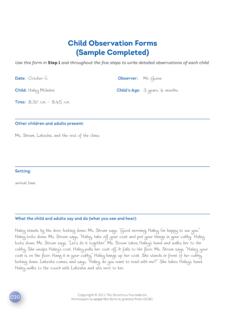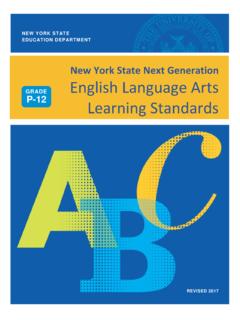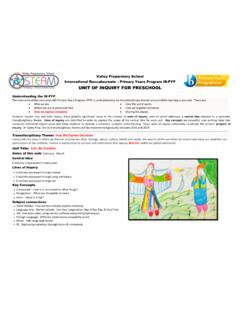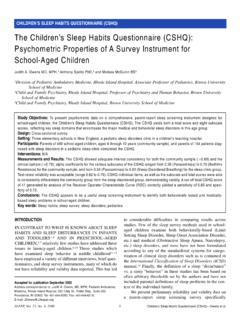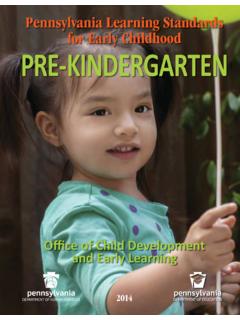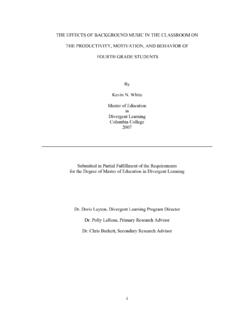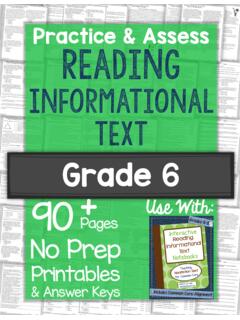Transcription of What is Challenging Behavior? - Devereux
1 Facing The Challenge - Trainer Guide 2007 Devereux Foundation7 What is Challenging Behavior? When using this segment of the Facing the Challenge DVD for training purposes, the following activities may help enhance the learning experience for participants. Optional pre-post questionsHandout 1:1/Pre-test What is Challenging Behavior? Handout 1:5/Post-test What is Challenging Behavior? Facing The Challenge - Trainer Guide 2007 Devereux Foundation What is Challenging Behavior? Program Content and Activity CueLet s look at a scene in an early childhood environment in which the teachers, like all of us, face difficult behaviors and, at times, respond in ways that don t help the child learn more positive behaviors:Incident Evaluation SequenceWe ll take another look at this sequence at the end of the program to examine what might be done in future situations like this to help the child learn more positive behaviors.
2 Meanwhile, let s begin answering the question: What is Challenging Behavior? Almost all children who have trouble controlling their behavior can learn new, more effective ways of tak-ing part in school activities and playing with their friends. A child often shows dramatic improvements in his behavior when he learns how to use his words or how to control his impulses. But, in order to have a chance to learn and use these new skills, a child has to be involved with adults who are committed to helping recent study conducted by Yale University indicated that over 5,000 children were expelled from pre-school in one year. This expulsion rate is more than 3 times that of children in kindergarten through the 12th grade . The study also described as many as one in every ten children as having a serious behavioral these children can be hard work.
3 Programs that expell young children often feel they can t help those few children using difficult behaviors while still meeting the needs of other children in the classroom. But the fact is, as a qualified teacher, you can help these children. You may not realize that you already have many of the skills needed to help children using Challenging behaviors. Interview - Tom Lottman, Children Inc. Teachers often times faced with Challenging behaviors - their first reaction is I m not prepared to deal with this, I don t have the training to deal with this. When in reality, if she simply reflected on the skills that she does have - I think that s the really key point, is that ability to really stop and do some self-reflection and take a look at what am I really good at?
4 And maybe that I m good at anticipating what the triggers are for that behavior. Well that s really going to give me some good warning. You know I might not know what to really do about that but I can learn then to become intentional about some kind of intervention at that point. So, I think really reflecting and developing an awareness of what skills you do have is the first step to real-izing that you might be able to develop the confidence and competence to deal with the Challenging behav-iors. Activity 1: Our Own Strengths 3:37 Dealing with Challenging behaviors is a normal part of some preschool teacher s jobs. Most children will, at times, use difficult behaviors as they try out different ways of interacting with the world around them or as they adapt to difficult situations like a family move, parental separations, a new sibling, recent changes within the classroom or other major events in their lives.
5 Usually children adapt quickly and stop using behaviors that aren t the most effective at helping them get what they want or sometimes a child doesn t stop using Challenging behaviors. Without help, this child s behavior will likely limit his ability to learn and grow. Determining the difference between behavior that is difficult but likely to improve and behavior that is Challenging and likely to require intervention comes with experience. Facing The Challenge - Trainer Guide 2007 Devereux Foundation The description of Challenging behavior used by some child development experts and cited in the book: Chal-lenging Behavior in Young Children by Barbara Kaiser and Judy Sklar Rasminsky, has three components. Chal-lenging behavior is defined as any behavior that: interferes with children s learning, development and successful play.
6 Is harmful to the child, other children or adults. puts a child at high risk for later social problems or school 2: Internalizing and Externalizing Behaviors 5:13 Aggressive behavior, like hitting, hair pulling and biting, can be Challenging in all three ways. That s why a child who hurts his friends in order to get what he wants and doesn t respond as expected to your efforts to teach classroom rules can turn your life upside down. These are the children that get your attention. But kids that don t disrupt the class may also need help. A child who is withdrawn or extremely shy is also at risk. She may not be likely to interfere with classroom learning or harm other children, but, because she is not engaging in classroom activities and developing the skills she ll need to succeed, she could be at high risk for later social problems or school failure.
7 Children whose main challenge is that they don t participate in classroom activities are often overlooked and can easily get left problems can stem from many causes. Before deciding to target a particular child for his Challenging behaviors, you should first look at your own teaching practices and learning environment to make sure you re encouraging positive interactions and experiences for all of the children. Each child is different and every group is unique. What has worked in the past may not be working now. Likewise, an activity that a group of children enjoys on a Wednesday may result in chaos on a Monday. Many problem behaviors can improve quickly with simple changes in the classroom s physical layout, rules or transition a child s behavior doesn t improve after you ve evaluated and modified the program, you may need to work with the child s parents and others to develop a targeted set of strategies called a Behavioral Intervention Plan.
8 The input of early childhood educators to this plan is critical. Your observations of the child s behavior and careful documentation of the potential causes and results of incidents will provide the raw material from which a plan can be developed. Interview - Chris Kelley, Training SpecialistI think, next to a parent, the teacher is really the link that builds the bridge between - this is something that is in our heads still or on paper as a plan and what becomes the practical daily reality. What we do is what really makes the difference. The old adage that when we talk about something and think about it and write about it is one thing but when we actually do it and work the plan and go back to the development process. We know that it doesn t have to be perfect the first time - that it is a work in progress and process.
9 That teachers are really a critical part, second only to the parents role in this. Teachers are an important influence and guide to a child s happiness and well-being. If the child uses Challenging behaviors, your relationship with the child may help you recognize why the behav-ior is occurring. When a child has difficulty learning new behaviors, one of your best tools in reaching out to the child will be the trust that lies at the heart of a positive - Mary Lou Hyson, Senior Advisor for Research and Professional Practice, NAEYC Positive relationships between adults and children, teachers and children, play an incredibly important role in Facing The Challenge - Trainer Guide 2007 Devereux Foundation 0supporting children s development and learning in all areas.
10 And, in this case, if teachers take the time up front, to get to know a child, to really understand, express interest in, build a positive, friendly, caring relationship with that child, that s really like money in the bank. With that relationship. then, when things get tough, when you the teacher need to implement a plan that is focused on some difficult, some Challenging behaviors that that child is showing, you re doing that implementation on top of this earlier positive relationship. It s going to make it easier for you and the child to move forward with that plan. There isn t a formula that you can use to build relationships with young children. With some children, commu-nication seems natural and easy. With others, you may need to be patient and willing to try different approaches until you find one that as children are different from one another, so are adults.

